
ページ読込中...

ページ読込中...

[English]
| 小松 進一 [教授] | 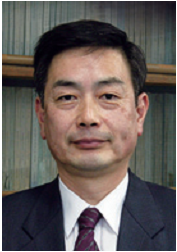 |
|
| homepage | https://www.opt.phys.waseda.ac.jp/ | |
| 専門分野 | 光物理工学研究 | |
| 研究テーマ・研究活動 | ||
| 1972 年 早稲田大学理工学部応用物理学科卒業 1974 年 早稲田大学院理工学研究科修士課程修了 理化学研究所研究員補 1978 年 理学博士(早稲田大学) 1980 年 早稲田大学理工学部・助教授 1985 年 早稲田大学理工学部・教授 |
||
光通信・情報機器からバイオ・宇宙にいたる先端科学技術の幅広い分野で、光は重要
な役割をはたしており、「21 世紀は光の時代」といわれています。
光は非常にすぐれた情報の担い手です。光波の振幅・位相・偏光状態などで、さまざ
まな情報を時間・空間・周波数の関数として表すことができますし、光の反射・屈折・
散乱・吸収・増幅などのいろいろな物質との相互作用を介して情報を高速・高密度に記録・再生することができるからです。また光の量子的な性質を利用すればさらにその可能性が拡がります。
本研究室では、新しいレーザー応用の開拓を中心として、光の波長より細かい微細構造の中での光のふるまいの解析から、新しい機能の光デバイスや多次元光情報処理システムの開発まで幅広く研究しています。
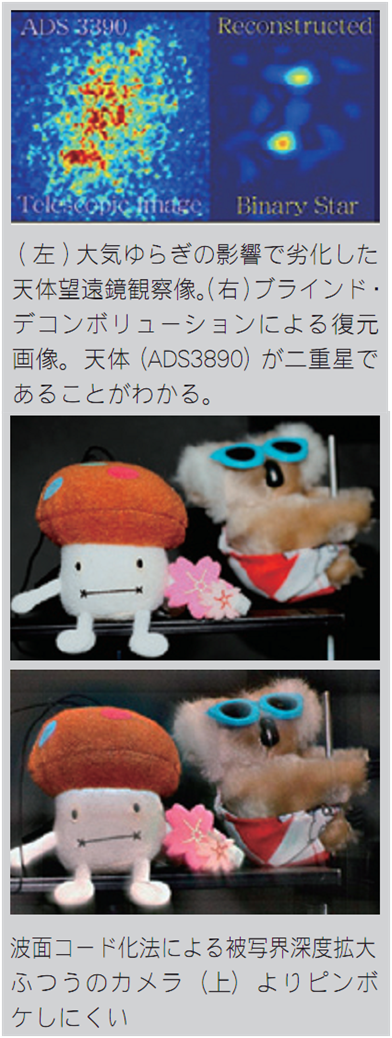
また、光と画像は縁が深く、光情報処理や可視化技術のほか、コンピューターによるデジタル画像処理にも取り組んでいます。
上の図には、劣化した星像だけを用いて元の天体の形を推定するブラインド・デコンボリューションの例が示されています。この図の左は望遠鏡で観測した天体写真で、大気の屈折率ゆらぎの影響を受け、すりガラスを通して眺めたように大きく像が広がっています。この天体写真のほかに手がかりがなくても、特殊なアルゴリズムを用いて画像復元を行うと、図の右のように、この天体が二重星であることがわかります。
下の図は、波面コード化法による被写界深度拡大実験の結果です。ふつうのカメラで撮影した写真(上)ではピンけしている遠方の物体が、下の図ではシャープに写っていることがわかります。
このほか、情報フォトニクス、光計測、イメージサイエンスの分野で、コンピュータを利用する像形成や可視化技術、補償光学の小型化・高機能化、光カオスによる秘匿通信、ファイバー・ブラッグ格子センサー、金属ナノ粒子鎖による光導波路などの最新の課題に、「不思議さ」に対する感覚を大切にしながら取り組んでいます。
| Shinichi Komatsu [Professor] |  |
|
| homepage | https://www.opt.phys.waseda.ac.jp/ | |
| research field | Extending Image Field Depth without Reducing Resolving Power and Light Intensity | |
| research keywords | ||
| Wave-front Coding for Extending Depth of Field Compact Adaptive Optics for Industrial Use Phase Recovery of Light Wave and Blind Deconvolution Heterodyne Laser Scanning Microscope Dynamic Phenomena of Laser Speckle |
||
| link | ||
| Research Profiles (at Faculty of Science and Engineering) | ||
Reducing the pupil size of an imaging lens is the most convenient way to extend the depth of field, but it inevitably results in the reduction of both the resolving power and the amount of light transmitted through the lens.
Wave-front coding (WFC) is well-known as an efficient technique for extending the depth of field without causing such inconveniences. The WFC technique requires a phase mask to modulate the pupil function of the lens as well as the corresponding post image processing for decoding. To achieve a further extension of the depth of field, we newly designed a freeform phase mask (FPM) instead of a conventional cubic phase mask (CPM). We optimized the shape of the FPM using the simulated annealing algorithm and confirmed that the optimized FPM provides a much larger focal tolerance and better final images than the CPM.The wave-front coding (WFC) system is a pupil-modulated optical system that presupposes the corresponding subsequent digital image processing, and has been extensively studied as one of the most effective means of extending the depth of field (DOF) of imaging systems. By placing a suitable phase mask (PM) in the exit pupil plane, we can obtain encoded intermediate images. After decoding the intermediate images, the WFC system may acquire various unique imaging properties. For example, if the decoded intermediate images become insensitive to defocus, only one deconvolution filter is sufficient to decode the intermediate images and obtain sharp final images irrespective of the amount of defocus, which is the basic principle of the extension of the depth of field (EDOF) using the WFC system.
The cubic phase mask (CPM) has been derived as an analytic solution that realizes the above-mentioned EDOF on the basis of wave optics using the stationary phase method.
The CPM is an analytical but approximate solution, and it is possible that other forms of phase masks provide better properties in the EDOF. Therefore we designed a freeform phase plate (FPM) whose distribution is expressed as the power series of pupil coordinates, the coefficients of which are determined by the optimization procedure based on the simulated annealing algorithm. It was shown on computer simulations that the optical transfer function (OTF) of the WFC system with the optimized FPM is less sensitive to defocus and that, compared to the CPM, the optimized FPM results in much better performance in terms of the EDOF.
The optimized FPM is fabricated by injection molding methods, and various experiments have been conducted with it to confirm that the WFC imaging system with the optimized FPM can greatly extend the depth of field of a well-corrected camera lens without causing significant artifacts, e. g., oblique fringe-like patterns that usually appear in the WFC imaging system with the conventional CPM.
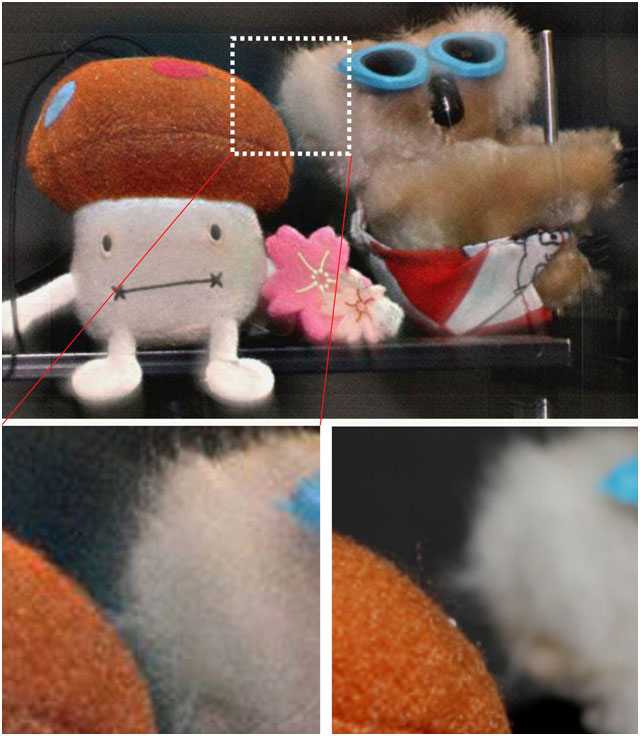
Top: Output image of WFC imaging system with the optimized FPM. Object B is imaged fairly sharp in spite of being outside the depth of field.
Bottom left: Enlarged part of Object B in the upper image. The detail of hair is clearly seen.
Bottom right: Corresponding enlarged part of blurred Object B that is imaged with an ordinary imaging system without WFC.
[English]
| 片岡 淳 [教授] | 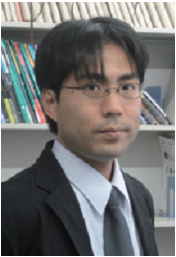 |
|
| homepage | https://www.spxg-lab.phys.waseda.ac.jp/ | |
| 専門分野 | 放射線応用物理学研究 | |
| 研究テーマ・研究活動 | ||
| 1995 年 東京大学理学部物理学科卒業 2000 年 東京大学大学院理学系研究科博士課程修了 理学博士 (東京大学) 2000―2001 年 京都大学理学研究科・学振PD 2001 年 東京工業大学大学院理工学研究科・助手 2007 年 東京工業大学大学院理工学研究科・助教 2009 年 早稲田大学理工学部・准教授 2014 年 早稲田大学理工学部・教授 |
||
人間の目で見える光は可視光と呼ばれ、波長が数百ナノメートル(1ナノメートル
は100 万分の1ミリ)の限られた帯域の光です。太陽などの恒星は可視で明るい天体ですが、これより5桁も10 桁も波長が短い(エネルギーが高い)X線やガンマ線でも明るく輝く「謎の」天体たちがいます。
大気に遮られ地上からは見えませんが、衛星や気球を用いれば、激動する宇宙の「生」の姿を捉えることができます。我々の研究室では、2008 年に打ち上げられたフェルミ・ガンマ線宇宙望遠鏡と日本の“すざく” 衛星を駆使した最先端の高エネルギー宇宙観測をおこない、また次期X 線天文衛星Astro-H の装置開発をJAXA、東工大、広島大などと協力しながら進めています。
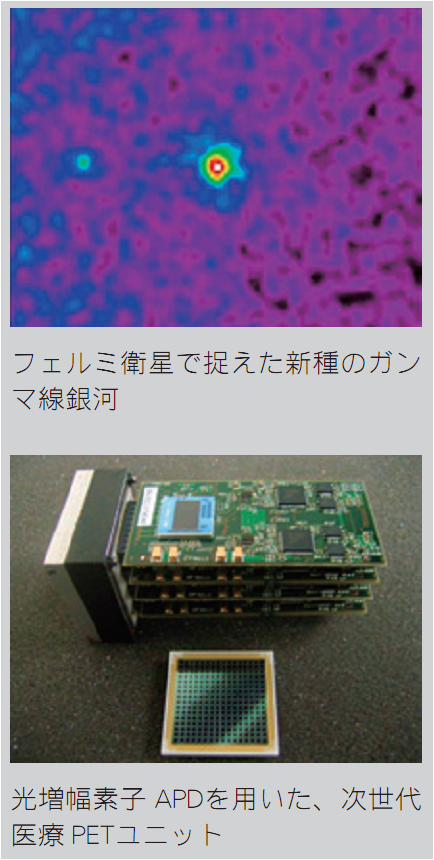
宇宙に限らず、レントゲン写真や空港の手荷物検査、放射線診断や治療など、日常生活でもX 線・ガンマ線が大きな貢献をしていることをご存知でしょうか?これら最先端の放射線検出器を社会に還元し、より良い人間生活のお役に立てたい、それが我々の次なる願いです。新しい光センサーとして内部増幅機能を持つシリコン半導体素子(APD/MPPC) の開発をすすめ、この分野では世界のトップレベルにあると自負しています。とくに、PET(陽電子断層撮影)と呼ばれるガン診断装置では、従来品より5~ 10 倍も解像度の良い、究極のガンマ線カメラ・ユニットの製作に成功しました。最近では、医療系だけでなく量子情報通信に用いる高感度光センサーの開発などにも着手しています。
我々の研究室は宇宙をベースにしていますが、最先端の物理計測はあらゆる分野・現場で必要とされ、分野の境界がありません。むしろ垣根を取り去った「横断的な」研究室が、ひとつくらいあっても良いのでは?という気持ちで研究を進めています。色々なテーマが混在しつつも新しい検出器の開発と、それを用いた科学に対する興味は共通です。学生同士も大変仲がよく、和気藹々と楽しくやっています。私達と一緒に「垣根を越えた」科学の醍醐味を味わいませんか?
| Jun Kataoka [Professor] |  |
|
| homepage | https://www.spxg-lab.phys.waseda.ac.jp/ | |
| research field | Gamma-ray astronomy, radiological physics, and technology | |
| research keywords | ||
| Gamma-ray astronomy Radiation detector Medical imaging |
||
| link | ||
| Research Profiles (at Faculty of Science and Engineering)Research Profiles (Elsevier SciVal Experts) | ||
Novel semiconductor devices that offer internal multiplication have recently entered wide use in the areas of particle physics, space science, nuclear medicine, and information engineering. We are, in particular, currently developing various photo-detectors, avalanche photodiodes (APDs), and multi-pixel photo-counters (MPPCs) for future applications in medical imaging and space satellite missions. The recent emergence of dual-mobility PET/CT imaging has profoundly affected clinical diagnoses in radiology, oncology, and other areas of nuclear medicine. However, CT exhibits poor soft-tissue contrast and exposes the patient to significant radiation doses that exceed those experienced with PET. The APD is a compact, high-performance light sensor that can be used in MRI-PET to provide ultimate sub-mm spatial resolutions. The very rapid response of MPPC devices will enable future PET detectors with time-of-flight (TOF) capabilities. We are also developing versatile APD- or MPPC-based PET modules for future applications in high-resolution, high-speed medical imaging. APD devices will also be used in the next Japanese X-ray astronomy satellite mission, Astro-H, currently slated for launch in 2013.
A subsequent research topic will involve the study of high-energy phenomena in the universe, including active galactic nuclei (AGNs), binary black-holes, neutron stars, supernova remnants, and gamma-ray bursts. Various modern astronomy satellites are currently used for this research, including the Fermi Gamma-ray Space Telescope (FGST; formerly known as GLAST), Chandra, XMM-Newton, and Suzaku. The successful launch of FGST will provide new opportunities to study gamma-ray emissions from various radio galaxies and galaxy clusters with unprecedented sensitivity. As a full partner of FGST, we currently take the lead for the AGN team in the areas of data analysis, calibration, operations, and software development. In one example, we recently reported on the discovery of a new type of gamma-ray galaxy; this can be found on the NASA website under the title “NASA’s Fermi Finds Gamma-ray Surprises.”(
https://www.nasa.gov/mission_pages/GLAST/news/galaxy_surprise.html)We are also active in analyzing Suzaku data. Recent interests include the unique identification of unidentified Fermi objects (UFOs) as potential “dark accelerators” in the universe.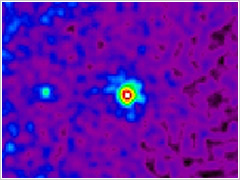
Gamma-ray radio galaxy NGC 1275 discovered using the Fermi gamma-ray space telescope
[English]
| 大谷 光春 [教授] | 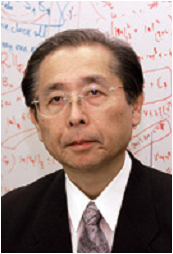 |
|
| homepage | ||
| 専門分野 | 非線形関数解析学研究 | |
| 研究テーマ・研究活動 | ||
| 1973 年 早稲田大学応用物理学科卒業 1978 年 東京大学大学院理学系研究科博士課程修了 1978 年 理学博士(東京大学) 1981 年 東海大学理学部数学科助教授 1990 年 東海大学理学部数学科教授 1990 年 早稲田大学理工学部教授 |
||
物理学や工学などに現れる重要な現象のほとんどは、「偏微分方程式」(複数の独立変数による微分が現れる微分方程式)によって記述されており、その多くは、「非線形性」と呼ばれる、「二つの解の足し算が必ずしも解にならない」という際立った性質をもっています。
これらの解を探す場所(空間)として、バナッハ空間やヒルベルト空間(ピタゴラスの定理が成り立つようなユークリッド空間の拡張概念)などと呼ばれる、無限次元空間をとり、ここでどのような解析学が成り立つかを研究する立場をとる学問が、「関数解析学」です。
無限次元の世界においては、有限次元における解析学と同様な多くの事実が成り立つと同時に、有限次元の常識では考えられない不思議なことも多く起こります。たとえば無限次元ヒルベルト空間においては、ベクトル列の収束(ベクトル列が、あるベクトルに近づいていくこと)に関して、強収束と弱収束という2 種類の定義ができますが、有限次元の場合、これらは同等な性質となってしまいます。さらに、有限次元空間においては、あるベクトル列が、長さを1に保ちながら0ベクトルに収束することは不可能ですが、無限次元空間ヒルベルト空間における弱収束の世界では、これが可能になります。
大谷研究室では、無限次元空間における非線形微分方程式を、主に、変分法的観点から研究しています。「変分法」とは、「物理法則に従って動く質点の運動や光の径路は、すべての可能な運動や径路のなかで、ある物理量を最小にするように選ばれている」すなわち、「自然は無駄をしない」という原理に基づく解析手法の総称です。
研究室において最近、「多孔質媒質方程式(均一に孔が分布している媒質中を水などが拡散するモデル)が無限回微分可能な解を許す」という長年の未解決問題が、肯定的に解決されるという大きな成果がありました。
あなたも、私たちと一緒に無限次元空間を変分法というコンパス( 羅針盤) をもって探検してみませんか?
| Mitsuharu Otani [Professor] |  |
|
| homepage | ||
| research field | Nonlinear Functional Analysis and its applications to nonlinear PDEs | |
| research keywords | ||
| Functional Analysis Nonlinear PDEs Nonlinear Evolution Equations Variational Method |
||
| link | ||
| Research Profiles (at Faculty of Science and Engineering) | ||
Nonlinear Partial Differential Equations: Differential Equations are the language in which the laws of nature are expressed. Understanding properties of solutions for differential equations is fundamental to much of contemporary science and engineering. Ordinary Differential Equations (ODEs) deal with functions of one variable, which can often be thought of as time. On the other hand, Partial Differential Equations (PDEs) deal with functions of several variables (of space and time). Most fundamental laws in physics are expressed in terms of Nonlinear PDEs, where the nonlinearity means that the sum of two solutions of the equations could not be a solution anymore, in other words, the principle of the superposition does not hold.
Evolution Equations: A function u(x,t) solving PDEs with time evolution depends on several variables, i.e., “x” for space and “t” for time. However, we can regard u(x,t) as a function u(t) of one variable “t” with value of u( ,t), which would lie in an infinite dimensional space X.
In this way, PDEs with time evolution can be reduced to ODEs in infinite dimensional spaces.
In fact, Heat Equations, Wave Equations, Schrodinger Equations, and many other important PDEs in physics and engineering can be written in abstract ODEs of the form: (E) du(t)/dt + Au(t) =0 in appropriate spaces X, called Banach spaces, and with operators A which work on X. In order to analyze this type of ODE, we must develop the theory of ODEs in Banach spaces, which is called the “Theory of Evolution Equations.” For this purpose, we need knowledge related to calculus in infinite dimensional spaces, called “Functional Analysis.”
Nonlinear Functional Analysis: Some important Nonlinear PDEs such as “Porous Medium Equations” (equations describing the diffusion process through porous mediums) are formulated as (E) by choosing suitable nonlinear operators A. In order to treat these cases, the theories of Nonlinear Evolution Equations and Nonlinear Functional Analysis are needed. Among them, the Nonlinear Semi-group Theory, which was initiated and developed by Japanese mathematicians, provides a remarkable tool. In particular, this theory reflecting the variational structure, called the subdifferential operator theory, which deals with the case where A is given as the functional derivative f(u) of convex functional f(u), is a most successful one for applications to Nonlinear PDEs. However, these theories work only for dissipative systems, whose energy is a monotone decreasing in time t, but cannot cover non-dissipative systems such as Navier-Stokes Equations, which is the fundamental equation in fluid dynamics.
We have been developing the perturbation theory for subdifferential operators, aiming at its application for not only Navier-Stokes-type equations but also for a wider class of non-dissipative PDEs systems including Nonlinear PDEs with nonlinear boundary conditions.
Other Topics: Our main interest is also related to the analysis of the asymptotic behaviors of solutions to Nonlinear PDEs, such as the blow-up of solutions and the existence of global attractors, etc., as well as seeking underlying hierarchical structures between the parabolicity and hyperbolicity of PDEs.
[English]
| 小澤 徹 [教授] | 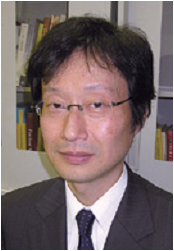 |
|
| homepage | https://www.ozawa.phys.waseda.ac.jp/index2.html | |
| 専門分野 | 数理物理学・非線型偏微分方程式研究 | |
| 研究テーマ・研究活動 | ||
| 1984 年 早稲田大学理工学部物理学科卒業 1988 年 名古屋大学理学部・助手 1990 年 京都大学理学博士 数理解析研究所・助手 1992 年 北海道大学理学部・講師 1993 年 北海道大学理学部・助教授 1995 年 北海道大学大学院理学研究科・教授 1998 年 日本数学会賞春季賞 受賞 2008 年 早稲田大学理工学術院・教授 |
||
ほとんど全ての物理現象は微分方程式としてモデル化・抽象化されます。しかし「シュレディンガー方程式、ディラック方程式、ナビエ・ストークス方程式などの物理学的に由緒正しい方程式には解が在って当たり前か?」となると、話はそう単純ではありません。物理現象を記述しているのは方程式の「解」であって「方程式そのもの」ではありません。「方程式そのもの」は書き下した瞬間「存在する」と言えるのでしょうが、方程式の「解の存在」は全く次元の異なる話題となります。また、「解の公式・具体的表示」と「解の存在」とは異なる概念です。後者は前者よりも広い意味を持っています。例えば、複素函数論で「複素係数のn( 1)次多項式は重複を許して丁度n 個の根を持つ」というガウスの代数学の基本定理を学びますが、これは「5 次以上の方程式は代数的には解けない」というアーベル・ガロアの理論とは何ら矛盾するものではありません。
さて、それでは「解の存在」とは何を意味するものなのでしょうか?そのためには、まず「解の概念」を明確に定義し、その上で「解の存在証明」を与える事が必要です。では何をもって「存在する」事を証明すれば良いのでしょうか?我々はその手段を解析学、特に函数解析学、調和解析学に求めます。そうなると、元来物理学から現れた偏微分方程式といえども、数学的対象として考える限り、徹頭徹尾数学的に扱わねばなりません。物理学的直感は役に立つ事もありますが、それを的確な数学的表現に置き換える作業が求められます。その様な思考過程の修業を経て初めて、物理現象の「数学的実在」が実感できるようになります。「数学的実在」とは目に見えないものですが、確かに実感できるものであり、数式などの記号を用いて自由に表現する事のできるものです。それは同時に、自分の個性の表現でもあり、自己の実現・実在を強烈に感じる機会を与えてくれるものです。小澤研究室は、物理と数学が交錯する場であると共に、志の高い人間の思考が相互作用し、世界の最先端の成果を発信する数理物理学道場を目指しています。
最後に現在取組んでいる課題と、対応する物理・応用物理の分野を並べて紹介します。
非線型双曲型方程式の研究 プラズマ物理、相対論、場の理論
非線型分散型方程式の研究 光通信工学、量子力学、場の理論
非線型楕円型方程式の研究 画像工学、材料工学、場の理論
流体力学の数学的基礎の研究 流体力学、連続体力学
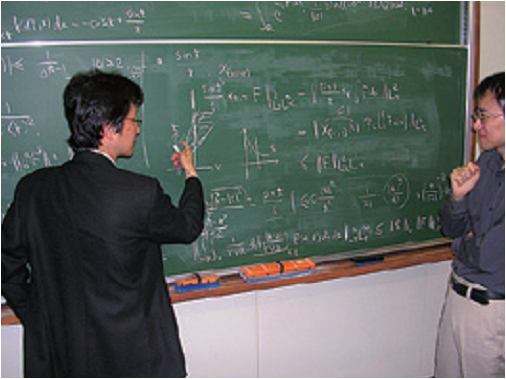
| Tohru Ozawa [Professor] |  |
|
| homepage | https://www.ozawa.phys.waseda.ac.jp/index2.html | |
| research field | The mathematical reality of classical field theory | |
| research keywords | ||
| Mathematical physics Classical field theory Scattering theory |
||
| link | ||
| Research Profiles (at Faculty of Science and Engineering) Research Profiles (Elsevier SciVal Experts) |
||
We cannot be assured of the validity of quantum field theory in any formulation without the deep mathematical theories drawn from the corresponding classical field theory.
In an address at the 1962 Conference on Analysis at Yale University on the occasion of Professor Hill’s retirement, Irving E. Segal remarked as follows: “To a considerable extent, relativistic physics is based in a theoretical way on non-linear partial differential equations. Until recently, however, there has been little applicable mathematical theory even in the classical (i.e., unquantized) case, although the subject is one of much intrinsic mathematical appeal. Probably the simplest non-trivial non-linear relativistic equations are those of the form \box \phi = F(\phi), …” (from his paper entitled “Non-linear Semigroups,” Annals of Mathematics, 78(1963), 339-364.)
Given this common motivation, studies of nonlinear partial differential equations in classical field theory got their start as a subject in mathematical physics.
Up to the 1980s, the world’s leading centers of research in this area were located in New York and Paris.
The names of some of the prominent scientists working in this area immediately come to mind: Morawetz, Strauss, Nirenberg, Klainerman, Shatah in the U.S. and Jorgens, Lions, Ginibre, Velo, Choquet, and Christodoulou in Europe. In Japan, the first research group in this area took shape here in the Department of Applied Physics at Waseda University. Based on original and pioneering work by Professor Riichi Iino and Professor Masayoshi Tsutsumi, research results gradually percolated out into the world community during the 1980s.
Since then, the Mathematical Physics Laboratory, Department of Applied Physics, Waseda University has produced a number of mathematical physicists active in this area, including Nakao Hayashi, Yoshio Tsutsumi, Hayato Nawa, Takayoshi Ogawa, and myself, to name a few. Individuals active in these laboratories are now recognized as a world-leading group in the mathematical study of classical field theory.
I returned to Waseda in 2008 to succeed Professor Masayoshi Tsutsumi. With Professor Mitsuharu Otani, I oversee the Laboratory of Mathematical Physics. My chief research interests involve classical field theory as a topic in mathematical physics. In terms of nonlinear partial differential equations, I have done work in the areas of nonlinear hyperbolic equations, nonlinear dispersive equations, and nonlinear elliptic and parabolic equations arising in pure and applied physics, particularly nonlinear Dirac, Klein-Gordon, Schrodinger equations, several associated systems of these equations, and fundamental equations in fluid mechanics. By exploring basic issues associated with these equations, such as the well-posedness of the Cauchy problem, long-time behavior of global solutions, regularity and singularity in local solutions, scattering theory, and asymptotic analysis, I seek to obtain a clearer picture of the mathematical reality of classical field theory. For more information, I encourage you to visit our Laboratory website.
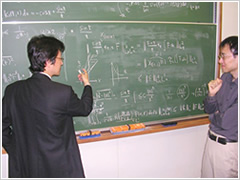
[English]
| 前田 恵一 [教授] | 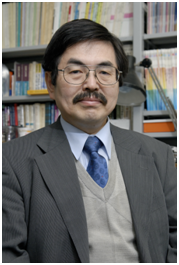 |
|
| homepage | ||
| 専門分野 | 宇宙物理 | |
| 研究テーマ・研究活動 | ||
| ○素粒子統一理論を基礎にした宇宙論・ブラックホール ○非線形物理学としての宇宙の構造形成 ○一般相対性理論の基礎的問題と重力波 |
||
| ●日本物理学会 日本天文学会 国際天文連合(IAU) アメリカ物理学会 日本「一般相対性および重力」学会組織委員 「一般相対性および重力」国際学会編集委員 |
||
研究内容:相対性理論を基礎にした理論宇宙物理学。主に次の3つの研究分野からなる。
(1)素粒子的宇宙物理学:ビッグバンは非常に成功した理論であるが、それらは同時に宇宙のはじまりを予言する。その宇宙のはじまりがどのようであったのか、どのようにビッグバン宇宙へと進化していくのかなどを素粒子論や超ひも理論をもとに考察している。また、素粒子の統一理論に基づいた新しいタイプのブラックホール解を見つけ、研究することにより、重力現象のより深い理解をめざしている。
(2)宇宙の構造形成と非線型物理学:宇宙の温度が4000度ぐらいの時、宇宙は中性化され光が自由に行き来できるようになる。そのときに存在した密度のでこぼこが成長し、現在の銀河や銀河団といった宇宙の構造が形成されるのであるが、そのメカニズムはまだ解明されていない。本研究室ではこの構造形成問題をカオスやフラクタルなどの非線型物理学の立場から研究している。
(3)ブラックホール・中性子星と重力波:アインシュタインの一般相対論によって新しく予言されたものに、ブラックホールと重力波がある。ブラックホールは星の進化の最後に形成されたり、銀河の中心に存在することが観測から示唆されている。一方、重力波も連星パルサーPSR1913+16の観測から間接的にはその存在が証明されている。現在では、その重力波を直接観測し、ブラックホールや中性子星の性質や形成過程を解明しようという大規模観測プロジェクトが世界各地で進められており、理論的にもその現象の詳細な解析が求められている。そこで数値相対論などを駆使し、中性子星やブラックホール形成過程やそれに伴う重力波放出過程の理論的解析にも力を入れている。
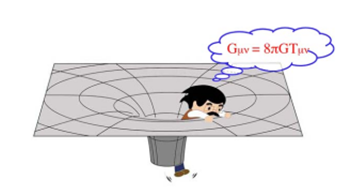
学生に一言:知識の丸暗記するだけで問題を解いたり、考えたりすることのないように。自分でちゃんと内容を理解することが重要である。特に、教科書に書かれているからとか、先生が言ったからというだけで正しいと信じてしまうことのないように。
| Kei-ichi Maeda [Professor] |  |
|
| homepage | ||
| research field | Research on cosmology and black holes as fundamental physics | |
| research keywords | ||
| General relativity and gravitational physics The Early Universe in unified theory of fundamental interactions Black holes and relativistic astrophysics |
||
| link | ||
| Research Profiles (at Faculty of Science and Engineering)Research Profiles (Elsevier SciVal Experts) | ||
I mainly work on gravitational physics and cosmology based on unified theories of fundamental interactions. In 1986, when I was a postdoc at the Meudon Observatory, I worked with Professor Gary Gibbons (Cambridge), who at the time was a visiting professor there,and found black hole solutions in string theory. The paper written with Gary is now one of the most popular papers in this field. The citation number in the SPIRES database at SLAC is now 712. When I visit Cambridge now, I always go to Gary’s office for useful discussions. This helps my research significantly.
In 1999, a workshop was held at the Isaac Newton Institute on “Structure Formation in the Universe.” During my sabbatical, I attended this workshop for three months. I had interesting discussions with numerous prominent scientists, including people at Cambridge. I began work on “a brane cosmology” there.
In particle physics, all interactions could be unified in higher dimensions.
However, our universe should be three dimensional. To explain our universe in the context of higher-dimensional unified theories, we introduce the idea of a brane, a three dimensional object moving in higher-dimensional spacetime.
Taking this model, many researchers have studied the early stage of the Universe or strong gravitational phenomena such as a black hole.
During the workshop, I finished four papers, which became the most widely cited ones in this field (The citation numbers are 831, 215, 176, and 124). One of these written with Professors Tetsuya Shiromizu (TITech) and Misao Sasaki (Kyoto) derives an effective gravitational theory for our universe based on the Randall-Sundrum brane world scenario.
I have published 181 papers to date. The total number of citations is over 5000, and the h index is 36.
I also manage international research collaborations. For example, I am the PI of the Japan-U.K. Research Cooperative Program (2005-09). I am also a member of the International Committee on General Relativity and Gravitation (GRG) and editor of the Journal of GRG.
Current topics include research on “cosmology and black holes” as fundamental physics. Inflation, which is believed to occur in the early stage of the Universe, is also entering a new stage and can now be discussed based on unified theories such as superstring theory. I recently presented a new type of inflation in a string model with correction terms.
I am also working on black hole solutions in string theory. More recently, my interests have turned to so-called dark energy, one of the most important subjects in modern cosmology. My goal is to continue this research and to find interesting new aspects in cosmology or gravitational physics.
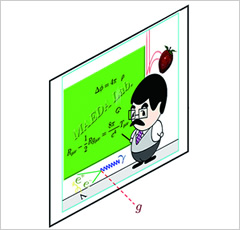 Based on the unified theory of fundamental interactions, our universe may be a membrane (three-dimensional space) moving in higher-dimensional spacetime. Standard model particles such as quarks and leptons as well as gauge particles such as photons and gluons are confined to the three-dimensional brane (our world), but gravitons can propagate in the higher-dimensional bulk space. This world view may change the scenario of the evolution of the early universe. It is called a brane world.
Based on the unified theory of fundamental interactions, our universe may be a membrane (three-dimensional space) moving in higher-dimensional spacetime. Standard model particles such as quarks and leptons as well as gauge particles such as photons and gluons are confined to the three-dimensional brane (our world), but gravitons can propagate in the higher-dimensional bulk space. This world view may change the scenario of the evolution of the early universe. It is called a brane world.
[English]
| 勝藤 拓郎 [教授] | 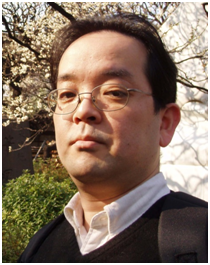 |
|
| homepage | https://katsuf.w.waseda.jp/lab/ | |
| 専門分野 | 物性物理学 | |
| 研究テーマ・研究活動 | ||
| ○遷移金属酸化物の物質開発 ○光学測定による強相関電子系の研究 ○巨大外場応答を示す物質の開発、研究 |
||
| ●日本物理学会 ●応用物理学会 ●アメリカ物理学会 |
||
みなさんの身の回りにある物質のほとんどは「固体」と呼ばれるもので、ミクロに見ると、原子が順序よく整列しており、その間を電子が飛び回っています。一見簡単に見える舞台ですが、実はこれだけで驚くほど多様な性質が生み出されるのです。よく知られている例として、電気が流れたり(金属)、流れなかったり(絶縁体)、磁石についたり(強磁性)、もう少し高級な例としては、近年のノーベル賞の対象となった超伝導、量子ホール効果などは、すべて固体中の電子が生み出す性質です。固体中においては、一つの現象に対して数多くの電子が一度に寄与するために、このような多彩な性質が現れるのです。1つ1つの電子は波動方程式(シュレディンガー方程式)に従いますが、電子が多数集まったとき、そこは単純な方程式を超えた新しい物理の宝庫です。
こうした多様で複雑な性質を研究するにはどうしたらいいでしょうか?まず、舞台となる物質をつくってやらなければなりません。新しい物理は新しい物質から生み出されるというのは、これまでの歴史の教えるところです。我々のグループは、新しい物理を生み出すべく、新物質の開発を行っています。特に、動きまわる電子同士の間に強い相互作用が働く「強相関電子系」の物質開発に力を入れています。さらに、新しい現象を見つけるためには、それを「見る」ための手段を手に入れなければなりません。我々のグループは、光を用いた測定手法を中心に、新しい物理を見るための手段を開発しています。このように、物質開発と測定の両輪をフル回転させて、新しい物理の探索にいそしんでいます。
。
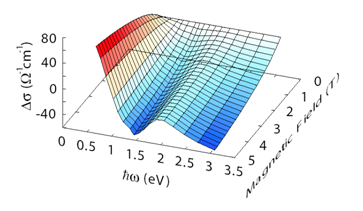
右の図は、マンガン酸化物という物質で我々が発見した、「有限周波数の電気伝導度」が磁場によって変化する様子です。これは電子が持つ「電荷自由度」と「スピン自由度」が結合することによって生じる新奇な現象であり、そのダイナミクスを明らかにする研究が進んでいます。
| Takuro Katsufuji [Professor] |  |
|
| homepage | https://katsuf.w.waseda.jp/lab/ | |
| research field | New physics through new materials | |
| research keywords | ||
| Strongly-correlated electron systems Synthesis of new materials Optical spectroscopy of materials |
||
| link | ||
| Research Profiles (at Faculty of Science and Engineering)Research Profiles (Elsevier SciVal Experts) | ||
While the behavior of a single electron obeys the Schrodinger equation and is physically counterintuitive, the principle in question is quite simple. However, real-world objects consist of countless electrons, and the collective motion of such large numbers of electrons differs radically from the motion of a single electron. Each material acts as a “stage” for electrons which, in this analogy, may be regarded as “actors.” The actors (the electrons) behave in different ways in different materials (on different stages). The potentially novel behavior of electrons on novel stages presents an avenue for exploring the physics of new materials.
Our group is currently seeking to synthesize new materials, grow new crystals, and explore new physics in these materials. In particular, we focus on transition-metal oxides, in which electrons are strongly correlated and tend to act collectively (called “strongly-correlated electron systems”). Due to the collective behavior of correlated electrons, transition-metal oxides often exhibit a large response to external fields, sometimes generating surprising behavior. For example, applying a magnetic field to some common materials will result in magnetization. Applying a magnetic field to transition-metal oxides may lead to changes in electrical resistance, dielectric constants, crystal structures, and even color. In addition to their interest in terms of basic physics, such phenomena present the potential for future applications.
To date, we have observed the following phenomena: (1) Magnetic-field-induced structural phase transitions in spinel MnV2O4, a phenomenon arising from the coupling of the orbital and spin degrees of freedom of the V ion; (2) large changes in dielectric constant in a perovskite (EuTiO3) when a magnetic field is applied, a phenomenon arising from the coupling between Eu spins and the electric dipole on Ti; (3) significant changes in color in a perovskite (Pr0.6Sr0.4MnO3) and pyrochlore (Yb2V2O7) when a magnetic field is applied; (4) significant changes in electrical resistance when a magnetic field is applied to La- and Cr-doped perovskite (SrTiO3). We wish to emphasize that such physical phenomena represent only a small portion of those related to new materials; we expect many more to appear in the near future.
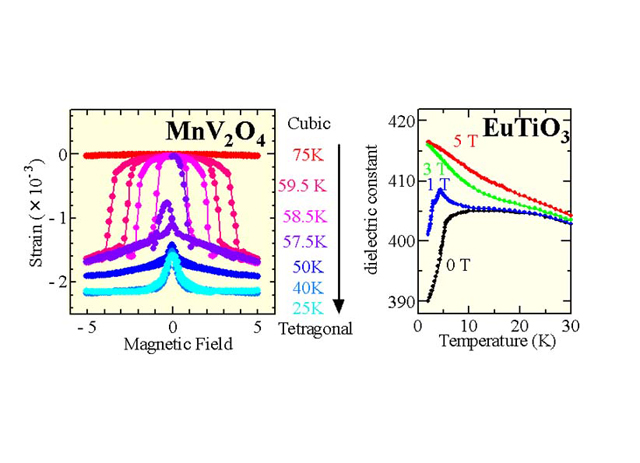 In conventional electromagnetics, magnetic fields induce magnetization only. In some transition-metal oxides, however, the effects of magnetic fields can be quite varied. (Left) Crystal structure of spinel MnV2O4 changes when a magnetic field is applied. (Right) Dielectric constants of perovskite (EuTiO3) change when a magnetic field is applied.
In conventional electromagnetics, magnetic fields induce magnetization only. In some transition-metal oxides, however, the effects of magnetic fields can be quite varied. (Left) Crystal structure of spinel MnV2O4 changes when a magnetic field is applied. (Right) Dielectric constants of perovskite (EuTiO3) change when a magnetic field is applied.
[English]
| 鷹野 正利 [教授・理工研] | 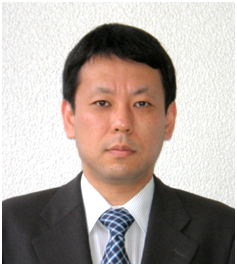 |
|
| 専門分野 | 原子核物理学 | |
| Homepage | https://www.np.phys.waseda.ac.jp/ | |
| 研究テーマ・研究活動 | ||
| ◯核物質状態方程式の研究と天体物理学への応用 ◯強い粒子間相関をもつFermi粒子系に対する変分法 |
||
| ●日本物理学会 ●アメリカ物理学会 |
||
原子核は核子(陽子と中性子)が核力という力で結合している系で、現在約3000種類の原子核が実験的に知られています。それらの膨大な実験データの多くについて、まだ理論的に十分な説明がなされていません。 原子核構造研究の困難さは2つの側面を持ちます。1つは、核力の複雑さです。核力は強い短距離引力と斥力芯から成り、また核子のスピンや速度等によって変化する、非常に複雑な力です。さらに、3つの核子の間に働く3体力も重要であると考えられています。 もう1つは、多体問題的側面です。一般に多体問題を解く事は困難ですが、例えば鉛の原子核208Pbは、82個の陽子と126個の中性子から成り、その構造を知るためには208体問題を解かなければなりません。現状で、これを厳密に解く事は不可能です。
そこで我々は、無限個の核子から成る無限に大きい仮想的な原子核(以下では核物質と呼びます)を考えます。そして、主に変分法を用いて、核物質の多体問題的研究を行う事により、核物質の観点から原子核の大局的性質を理解する事を目指します。 核物質エネルギーの理論計算により、いわゆる核物質の状態方程式(EOS)が得られます。計算された核物質EOSの信頼性を調べるために、我々は宇宙に目を向けます。
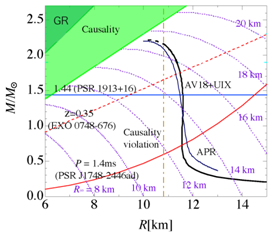 「仮想的」な無限に大きい核物質は、中性子星という天体の姿で存在します。中性子星は超高密度の天体で、非常に強い自己重力に対して、内部核物質の硬さが星を支えています。よって、中性子星の構造研究には、核物質EOSの情報が必要です。また逆に、中性子星観測結果との比較で、計算された核物質EOSの信頼性が確認できます。(図は中性子星の半径と質量の関係を表します。)さらに、恒星の進化の最終段階で起こる超新星爆発のきっかけも、核物質の硬さにあると考えられ、そのような天体現象の理解には、核物質EOSの情報が不可欠です。 このように核物質EOSは、原子核物理学、天体物理学で重要な役割を果たしますが、これを実験的に決定する事は困難で、信頼性の高い理論多体計算が必要です。我々のグループでは、こうした中性子星、超新星爆発等の天体現象の理論的研究に適用可能な核物質EOSの研究を行っています。
「仮想的」な無限に大きい核物質は、中性子星という天体の姿で存在します。中性子星は超高密度の天体で、非常に強い自己重力に対して、内部核物質の硬さが星を支えています。よって、中性子星の構造研究には、核物質EOSの情報が必要です。また逆に、中性子星観測結果との比較で、計算された核物質EOSの信頼性が確認できます。(図は中性子星の半径と質量の関係を表します。)さらに、恒星の進化の最終段階で起こる超新星爆発のきっかけも、核物質の硬さにあると考えられ、そのような天体現象の理解には、核物質EOSの情報が不可欠です。 このように核物質EOSは、原子核物理学、天体物理学で重要な役割を果たしますが、これを実験的に決定する事は困難で、信頼性の高い理論多体計算が必要です。我々のグループでは、こうした中性子星、超新星爆発等の天体現象の理論的研究に適用可能な核物質EOSの研究を行っています。
| Masatoshi Takano [Professor] |  |
|
| homepage | https://www.np.phys.waseda.ac.jp/eng.html | |
| research field | Theoretical study of Nuclear Equation of State | |
| research keywords | ||
| Equation of state for nuclear matter Variational method Neutron stars Supernovae |
||
| link | ||
| Research Profiles (at Faculty of Science and Engineering)Research Profiles (Elsevier SciVal Experts) | ||
The atomic nucleus is a quantum-mechanical system composed of nucleons (protons and neutrons) interacting through nuclear and Coulomb forces. One of the fundamental properties of the atomic nucleus is the so-called “saturation property of nuclear forces,” i.e., that the nucleon number densities inside the nuclei and the binding energies per nucleon are nearly constant for all nuclei. In order to explain this basic property of the atomic nucleus quantitatively, the Schrodinger equation for the atomic nucleus must be solved. So far, however, this has not been achieved because the nuclear Hamiltonian, especially the potential of the nuclear force, has some uncertainty. More seriously, the quantum many-body problem is especially difficult to solve.
In order to overcome the latter difficulty, we have been studying the quantum variational many-body theory for infinitely-large fermion systems. The variational method is a powerful technique to treat the quantum systems in which the particles interact through strong short-range forces, such as infinite hypothetical nuclear matter and liquid helium. In the case of liquid 3He, the spin-1/2 3He atoms interact through intermolecular forces, and the Hamiltonian bears some resemblance to that of nuclear matter. Furthermore, the experimental data to be compared with the theoretical calculations for liquid 3He are more abundant than in the case of nuclear matter. Therefore, we are studying not only nuclear matter but also liquid 3He.
Infinitely-large nuclear matter can be found as neutron stars. A neutron star is a compact object whose mass is about twice the solar mass (or somewhat less), with the radius being about 10 kilometers. Inside the star is high-density nuclear matter. Against strong self-gravity, the stiffness of the interior nuclear matter supports the neutron star. Therefore, the neutron star structure is determined by the stiffness of the interior nuclear matter, or more generally, by the equation of state (EOS) of nuclear matter. Furthermore, owing to the recent development of neutron star observations, various constraints are imposed on the nuclear EOS. We are studying the neutron star structure in connection with the nuclear EOS obtained with our variational method.
The nuclear EOS is also important for studies of core-collapse supernovae and other high-energy astrophysical phenomena such as hypernovae, black-hole formations, and neutron star mergers. In order to study these astrophysical phenomena with numerical hydrodynamic simulations, the EOS of nuclear matter covering an extremely wide range of densities, temperatures, and proton fractions is necessary. We are constructing a new nuclear EOS appropriate for these astrophysical phenomena based on the variational many-body theory.
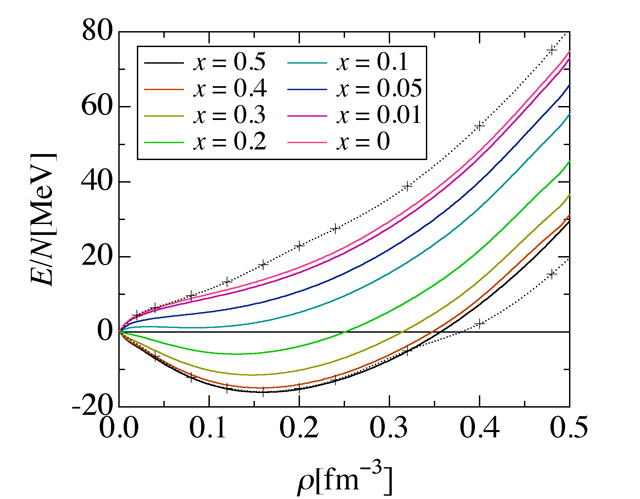 Energies per nucleon of asymmetric nuclear matter at zero temperature E/N for various proton fractions x, as functions of the nucleon number density ρ. The AV18 and UIX potentials are employed for the two-body and three-body nuclear forces, respectively. The dotted curves with crosses are with the Fermi Hypernetted Chain calculation for x = 0 (upper one) and x = 0.5 (lower one) by Akmal et al. (PRC58[1998]1804).
Energies per nucleon of asymmetric nuclear matter at zero temperature E/N for various proton fractions x, as functions of the nucleon number density ρ. The AV18 and UIX potentials are employed for the two-body and three-body nuclear forces, respectively. The dotted curves with crosses are with the Fermi Hypernetted Chain calculation for x = 0 (upper one) and x = 0.5 (lower one) by Akmal et al. (PRC58[1998]1804).
[English]
| 山田 章一 [教授] | 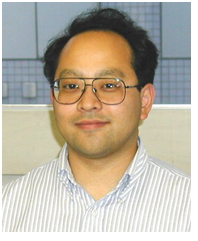 |
|
| homepage | https://www.heap.phys.waseda.ac.jp/index.php | |
| 専門分野 | 宇宙物理 | |
| 研究テーマ・研究活動 | ||
| ○高エネルギー天体の物理 | ||
| ●日本天文学会 ●日本物理学会 |
||
宇宙には、地上では考えられないような高エネルギーの現象がたくさんあります。私が主たる研究テーマとしている超新星もその一つです。超新星は突発天体で、ある日突然明るく輝きだし、数ヵ月の単位で暗くなっていきます。昔の人には新しい星の誕生ととらえられ、超新星と名付けられていますが、超新星は新しい星の誕生ではなく、実は非常に大きな星が爆発を起こして死んでゆく姿です。超新星は非常に明るい天体です。銀河は100億個程度の星の集まりですが、超新星はそれ一つでこの銀河一つ分に匹敵する明るさを持っています。爆発のエネルギーに直すと、太陽から地球が一年間に受けるエネルギーより、約20桁も大きなものになります。しかもこの莫大なエネルギーがわずか1秒という時間のうちに放出されます。どれほどの高エネルギーであるか想像していただけるでしょうか。このような高エネルギー現象では、いろいろ地上では考えられないようなことが起こります。神岡鉱山の観測装置スーパーカミオカンデでは太陽や宇宙線から生じるニュートリノという素粒子を観測していますが、超新星は莫大な量のニュートリノを放出します。事実、1987年に我々の天の河銀河のとなりにある大マゼラン星雲という銀河で起きた超新星では、スーパカミオカンデの前身であるカミオカンデ観測器により世界で初めて超新星ニュートリノが観測され、小柴さんがノーベル賞を受賞しました。また、超新星が起こった後には、中性子星やブラックホールといった、宇宙のいわゆるコンパクト高エネルギー天体が形成されると考えられており、超新星の研究はこうした興味深い天体の形成メカニズムを研究することにもなるわけです。
最近では、超新星以外にもいろいろな高エネルギー天体が注目をあつめています。γ線バーストはおよそ1日に1回の頻度で宇宙のあらゆる方向から等方的にγ線がやってくるという現象です。γ線は最もエネルギーの高い光で、これを発している天体現象はまだよく分かっていませんが、大質量星が重力崩壊しブラックホールになる過程でγ線バーストは起こっているのだろうと考えられており、超新星とも密接に関係していると思われています。下図左は、ブラックホールが形成される際に放出される高速ガス流(ジェット)のシミュレーション結果です。他にも、地上で最も強い磁石より10桁以上も強い磁場を持った中性子星が発見されており、どのようにしてそのような強い磁場ができるのか、多くの人が興味をもって研究しています。下図右に示したのは、高速に自転する超新星コアの中で磁力線が乱流のために複雑に絡みあい、磁場が強くなる様子をシミュレーションで計算したものです。観測的にも、従来の電磁波によるものだけでなく、ニュートリノや重力波を用いてこうした高エネルギー天体を観測する”新しい天文学”が開花しつつあり、高エネルギー天体物理学は今非常に面白い時期を迎えています。上述のように、こうした高エネルギー天体は互いに密接に関係していると思われ、これらを統一的に理解することが今後重要になっており、私の研究もそうした方向に向かっています。
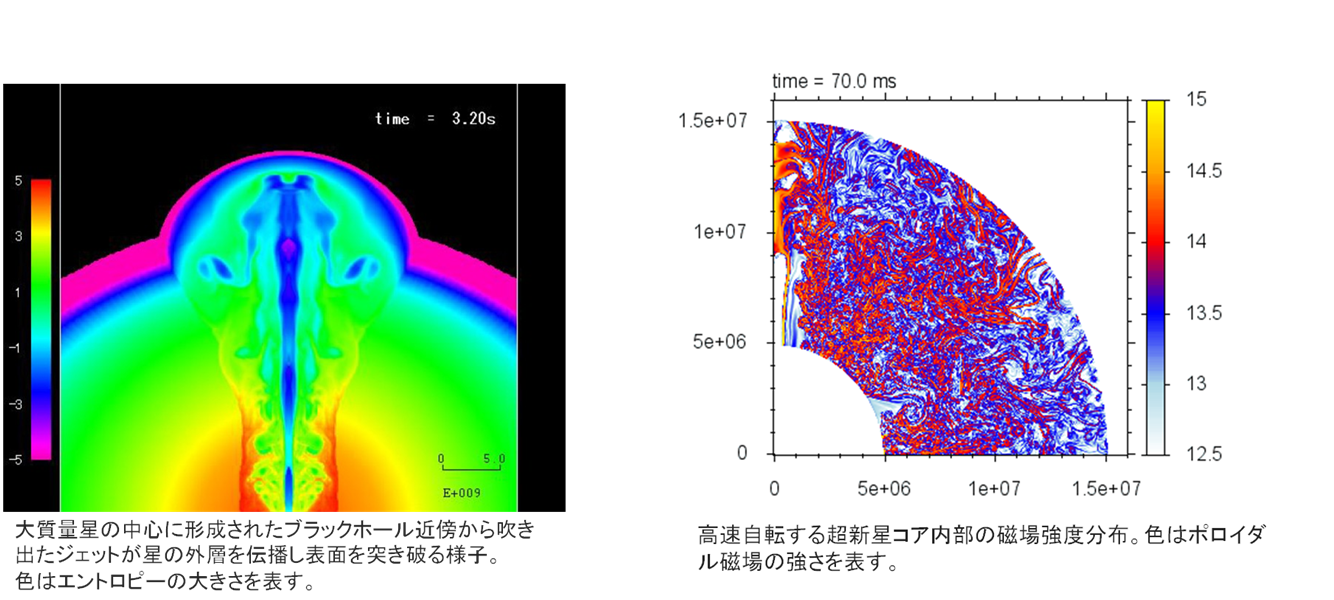
| Shoichi Yamada [Professor] |  |
|
| homepage | https://www.heap.phys.waseda.ac.jp/index-e.php | |
| research field | Neutrino and gravitational wave astronomy of massive-star collapse | |
| research keywords | ||
| High energy astrophysics Mechanism of collapse-driven supernovae and physics of hadronic matter at high densities Neutrinos and gravitational waves from the formation of black holes and neutron stars |
||
| link | ||
| Research Profiles (at Faculty of Science and Engineering)Research Profiles (Elsevier SciVal Experts) | ||
Gravitational collapse is the common fate of massive stars, followed by the formation of compact objects such as neutron stars and black holes. This gravitational collapse is initiated by the central core of a massive star, which is surrounded by massive envelopes and cannot be probed by electromagnetic waves. The actual conditions in these regions have been inferred over the years based on indirect evidence for example, nucleosynthetic yields. This may have already changed dramatically, however, with multiple terrestrial detectors of neutrinos and gravitational waves now deployed, operating, and poised to detect the next event.
Since neutrinos and gravitational waves interact very weakly with matter, they escape the central core unhindered, carrying information on the environment where the emissions originate. Although the very weakness of the interactions once constituted a major challenge for experimentalists, this is no longer the case. The ball is once again in the theoreticians’ court. Needed now are quantitative predictions to compare against observations. As the detection of neutrinos from SN1987A clearly demonstrates, neutrinos from core-collapse supernovae and the proto-neutron stars that form subsequently should be among the primary targets in neutrino astronomy.
Also emerging now is gravitational-wave astronomy. Over the last decade, we have witnessed significant progress in the international network of detectors, including LIGO, VIGRO, GEO600, TAMA300, and AIGO, and the direct detection of gravitational waves from astrophysical events should soon be possible.
Promising sources would include a massive star collapse, particularly within our own galaxy.
Over the years, in large-scale numerical simulations, we have demonstrated that the detection of neutrinos and/or gravitational waves emitted by the gravitational collapse of massive stars will convey much information not just about what goes on under the thick veil of the massive envelopes, but about the properties of dense and hot baryonic matter. In so doing we have pointed out the importance of black-hole-forming events, which are still putative but, if observed, will provide invaluable and otherwise inaccessible information. In fact, the neutrino bursts from the optically silent collapses of massive stars have unique characteristics that distinguish them from ordinary supernova neutrinos; hence, they can be used not just as indicators of black hole formation, but as probes of dense baryonic matter. It is fascinating that such an event may be confirmed by the detection of “the disappearance of one of the numerous massive stars” monitored optically as another proposed initiative. If the progenitor star is rotating, we will also have the chance to detect the event via gravitational waves.
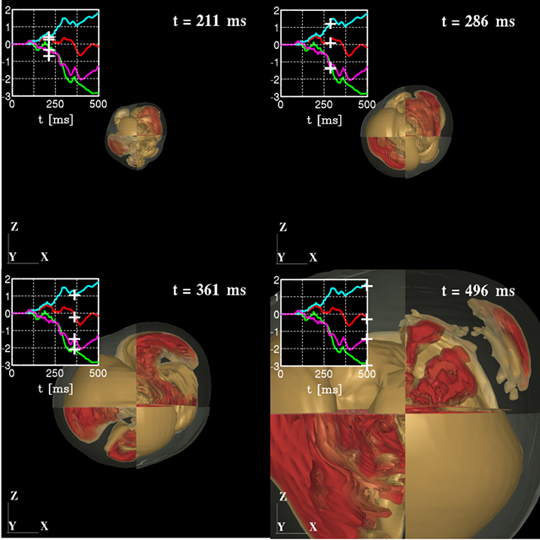
Four snapshots of our 3D supernova simulation. The length of each side of the plot corresponds to 1000 km. The entropy distributions are shown. The second and fourth quadrants of each panel show the surface of the shock wave. The high entropy bubbles (colored red) in the section cut by the $ZX$ plane are displayed in the first and third quadrants. The insets show gravitational waveforms from anisotropic neutrino emissions.
[English]
| 中里 弘道 [教授] | 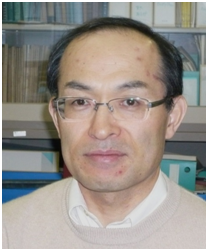 |
|
| homepage | https://www.hep.phys.waseda.ac.jp/index-j.html | |
| 専門分野 | 量子力学基礎論、素粒子理論 | |
| 研究テーマ・研究活動 | ||
| ○量子論の基礎に関わる諸問題 ○量子化法の研究 ○場の量子論 |
||
| ●日本物理学会 ●アメリカ物理学会 |
||
原子や原子核、さらにはそれらを構成している素粒子といった極微の世界を支配する力学が量子力学です。こういった極微の世界では私たちの日常とは全く異なる「非日常の世界」が広がっています。皆さんはヤングの干渉実験をご存知ですね。光を二重スリットに通すとスリットの向こうのスクリーン上に明暗の縞が写るという実験です。この事実は光が空間的に広がった波であること示しています。二つの波を重ね合わせると、それぞれの波の山や谷が強め合ったり弱め合ったりします。このことを「干渉」と呼びます。波特有の性質です。二重スリットの実験の場合、二つのスリットそれぞれからやってきた光の波が干渉し、その強弱がスクリーン上に縞となって現れると説明されます。
実は、同じような実験を「電子」に対しても行うことができ干渉縞を見ることができます。電子は波動としての性質を持つのです。その一方で、投入する電子の数が少なければ電子の粒子性を見ることができます。スクリーン上で輝点が現れるのは電子がやってきたところだけで他には現れないからです。しかし、電子を次々に投入すると、スクリーン上に電子がやってきたところ、やってこないところと、はっきりと縞模様が浮かび上がってきます。「干渉縞」つまり波動性の出現です。
大切なことは、その干渉は二つの電子同士の干渉ではないことです。一つの電子を二重スリットに投入した場合、スクリーン上に電子到達の輝点が決して現れないところがあります。そこが多数個の電子を投入した場合に現れる干渉縞の暗い所です。実は片方のスリットをふさいでしまうと、そのような点にも電子はやってきます。つまり干渉縞が現れるためには二つのスリットがあるということが肝要です。
このように電子のような極微の世界の粒子は空間的に広がった波としての性質と空間的に局在した粒子としての性質を兼ね備えていると考えざるを得ないのです。状況によって波になったり粒子になったり...なんとも不可思議な状況です。このような状況を適切に記述しているのが量子論と呼ばれる理論体系で、現代物理学の柱の一つとなっています。実際、これまでのところ量子論に矛盾した実験事実は一つとして報告されていません。
量子力学の創成から80年以上が過ぎてようやく量子力学独自の性質(例えば「重ね合わせの原理」)を直接応用するアイデアが実験室で実現可能になってきました。量子暗号とか量子通信、量子計算などという単語を聞いたことがあるでしょう。量子情報技術と呼ばれる分野の研究です。そこでは、従来は(実現不可能として)無視されてきた事項も真剣に考え直さなければならなくなっています。私たちの研究室では、量子力学に従ってこのような状況の理論的解析を行っています。また、素粒子論で中心的役割を果たす場の量子論、あるいは量子化自体の問題など、幅広く量子論の課題に取り組んでいます。
| Hiromichi Nakazato [Professor] |  |
|
| homepage | https://www.hep.phys.waseda.ac.jp/ | |
| research field | Theoretical study of quantum dynamics and its applications | |
| research keywords | ||
| Quantum dynamics Quantum-classical border Quantum field theories |
||
| link | ||
| Research Profiles (at Faculty of Science and Engineering) | ||
Since its advent more than 80 years ago, quantum theory, which describes behavior in the microscopic world from molecules and atoms down to elementary particles, has solidified its status as one of the most successful theories in modern physics. Although its validity has been confirmed in many fields in physics to an unprecedented degree of precision, quantum theory has been plagued since its birth with certain fundamental issues, which remain unresolved due to the difficulty of achieving experimental counterproof. Recent technological advances have dramatically altered this landscape, allowing the examination of such issues in laboratory experiments. To date, no results that contradict quantum theory have been reported. Moreover, new ideas based on the very fundamental rules of quantum theory (e.g., the superposition principle) have emerged and are being applied in the laboratory in real-world physical systems.
At the same time, these technological innovations have forced major reappraisals of physical processes. For example, an ideal system consisting of an isolated atom cannot in fact exist in the real world. At all times, we must account for the environment, or external agency, including the act of measurement, with which quantum systems are unavoidably implicated. The environment affects dynamics and causes phenomena like dephasing and/or dissipation resulting in loss of quantum coherence (decoherence), a key issue in quantum information and technologies for which the preservation of quantum coherence is crucial. A correct understanding of quantum processes is essential to realizing real-world applications of the ideas proposed in association with such fascinating keywords as quantum computers and quantum cryptography; these applications must be realized as real physical processes in the laboratory, not as mathematical formulas on paper.
Our research explores the dynamics of quantum systems under the influence of the environment, first by treating the whole system composed of the quantum system and its environment as a closed quantum system, then by tracing the environmental degrees of freedom. The resulting dynamics is no longer unitary and would lead to decoherence in the quantum system. Understanding the associated mechanisms and finding possible ways to avoid decoherence are key issues related to the primary subjects of our current research. These issues have deep connections to profound and interesting questions, including where or how the border between quantum and classical worlds can be defined and when classical rules predominate over quantum rules. These questions also fall within the scope of our research efforts, and we study the transitions between different theoretical frameworks (e.g., classical or quantum, particle or field), seeking a deeper understanding of the meaning of quantization or devising novel methods of quantization.
[English]
| 安倍 博之 [教授] | 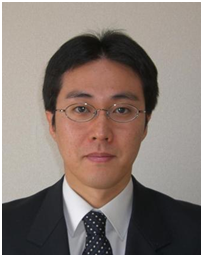 |
|
| homepage | https://www.hep.phys.waseda.ac.jp/index-j.html | |
| 専門分野 | 素粒子理論 | |
| 研究テーマ・研究活動 | ||
| ○素粒子標準理論を超える物理 ○超対称理論・高次元時空理論 ○超重力理論・超弦理論の現象論的側面 ○素粒子の究極的統一理論 |
||
| ●日本物理学会 | ||
現在確認されている自然界の最も基本的な構成要素は、クォーク及びレプトンと呼ばれる物質粒子と、それらの間に働く力を媒介する各種のゲージ粒子で、これらをまとめて素粒子と呼びます。私たちの世界のすべての物質は種々の原子から構成されており、これらを拡大してみると原子核の周りを電子が回っているという基本構造が見えますが、原子核は更に陽子や中性子の複合体です。電子はこれ以上分割できず、それ自体がレプトンと呼ばれる素粒子に分類されますが、陽子と中性子は更にクォークと呼ばれる素粒子の複合体であることが分かっています。クォークやレプトンの間に働く力は、電磁気力・弱い力・強い力・重力の4種類があり、これらがうまく働き合って我々の世界が形成されています。重力以外の3つの力は素粒子標準理論と呼ばれるゲージ場の量子論で大変うまく記述できることが実験で確認されていますが、この標準理論にも数々の理論的問題が存在します。例えば(量子論的)重力を含んでいないことや素粒子の質量を定量的に予言できないことなどが挙げられます。
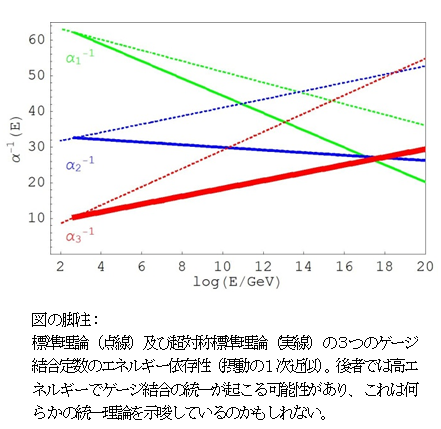 私たちの研究室では、(現在知られている唯一矛盾のない量子重力理論である)超弦理論の有効理論として標準理論が実現されている可能性を念頭に置いて、素粒子理論の研究、特に標準理論を超える物理の理論的研究を行っています。超弦理論が素粒子の究極的統一理論だとすると、標準理論を超える物理として、ボーズ粒子とフェルミ粒子を入れ換える超対称性や、高次元時空に起因する余剰空間次元の存在などが予言され、これらの力学や幾何学が、観測されている素粒子の複雑な質量階層構造などを決定していると考えられます。また、超対称性や余剰次元から帰結される数々の新粒子の存在は、高エネルギー物理現象や宇宙の歴史にも重要な影響を与えると考えられ、これらの理論を研究し高エネルギー実験や宇宙論的観測による検証を行うことは現代の基礎物理学の重要な課題の1つです。
私たちの研究室では、(現在知られている唯一矛盾のない量子重力理論である)超弦理論の有効理論として標準理論が実現されている可能性を念頭に置いて、素粒子理論の研究、特に標準理論を超える物理の理論的研究を行っています。超弦理論が素粒子の究極的統一理論だとすると、標準理論を超える物理として、ボーズ粒子とフェルミ粒子を入れ換える超対称性や、高次元時空に起因する余剰空間次元の存在などが予言され、これらの力学や幾何学が、観測されている素粒子の複雑な質量階層構造などを決定していると考えられます。また、超対称性や余剰次元から帰結される数々の新粒子の存在は、高エネルギー物理現象や宇宙の歴史にも重要な影響を与えると考えられ、これらの理論を研究し高エネルギー実験や宇宙論的観測による検証を行うことは現代の基礎物理学の重要な課題の1つです。
| Hiroyuki Abe [Professor] |  |
|
| homepage | https://www.hep.phys.waseda.ac.jp | |
| research field | Theoretical high-energy physics | |
| research keywords | ||
| Particle phenomenology Quantum field theory Supersymmetry Supergravity and superstring Higher-dimensional spacetime |
||
| link | ||
| Research Profiles (at Faculty of Science and Engineering) | ||
The most fundamental elements of nature observed by people are elementary particles called quarks, leptons (matter particles), and gauge bosons (force mediators). The electron and the neutrino are classified as leptons, while the proton and the neutron are composite particles each formed by three quarks. A quantum field theory with special local symmetries, called the “standard model” of elementary particles, describes whole observed phenomena at the present time without inconsistencies. From the theoretical point of view, however, there exist many unsatisfactory points in the standard model, beginning with the unpredictability of the masses of elementary particles, the lack of gravitational interactions, and so on.
In a quest for an ultimate fundamental theory of nature beyond the standard mode, one of the most severe obstacles is the extension of quantum field theory as it includes gravitational interactions, i.e. the harmonization of quantum theory with general relativity. A single known theory that overcomes such obstacles without any theoretical inconsistencies is the “superstring theory.” It possesses a special symmetry called supersymmetry under the exchange of bosons and fermions, and is defined in ten-dimensional spacetime. If our real world is a product of superstring theory, there should exist supersymmetry and six extra space dimensions that are possibly hidden in such a way that we never detect them due to the energy shortage of present particle colliders.
Considering the possibility that the standard model appears as a low-energy effective theory for superstring, we perform various theoretical and phenomenological studies for physics beyond the standard model. We have to search candidates for realistic structures among huge numbers of superstring vacua, for which the key ingredients are “supersymmetry” and “extra-dimensions.” These imply the existence of new particles at low energy called superparticles and moduli. We aim to find an ultimate unifying theory of elementary particles and gravity, by analyzing the dynamics and the geometry of these ingredients and accomplishing the harmonization of the standard model with the superstring theory. In these studies, we derive theoretical predictions for precise values of known and possibly new observables, which are compared with real observed values in the past and future high-energy experiments as well as cosmological observations, and then verify the validity of each candidate for an ultimate unified theory of elementary particles.
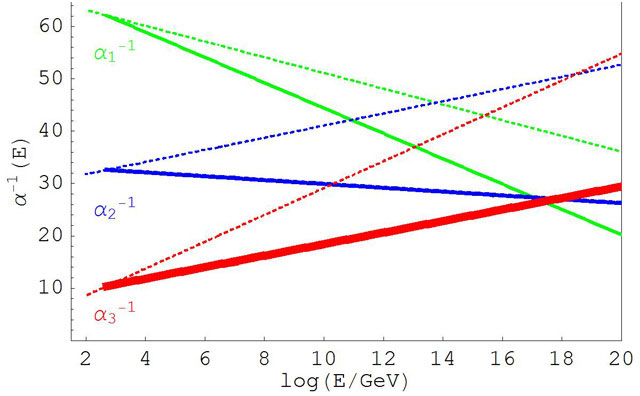 The energy dependence of three gauge coupling constants determined by the observed values at low energy in the standard model (dotted-lines) and in a supersymmetric extension of the standard model (solid-lines) at the first order of perturbative expansion. In the latter supersymmetric model, a gauge coupling unification occurs at a high energy, which would imply some underlying unification theory.
The energy dependence of three gauge coupling constants determined by the observed values at low energy in the standard model (dotted-lines) and in a supersymmetric extension of the standard model (solid-lines) at the first order of perturbative expansion. In the latter supersymmetric model, a gauge coupling unification occurs at a high energy, which would imply some underlying unification theory.